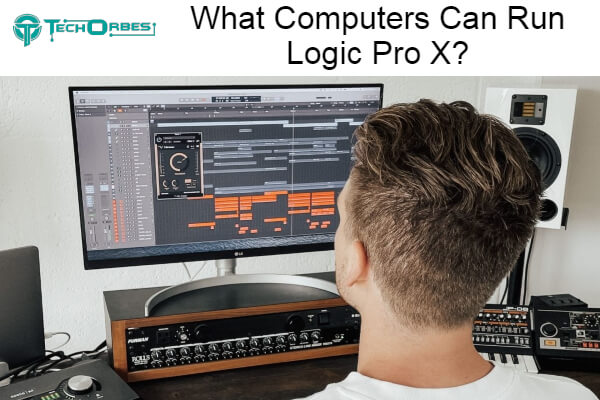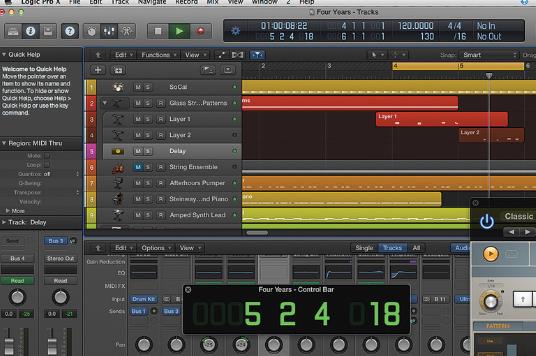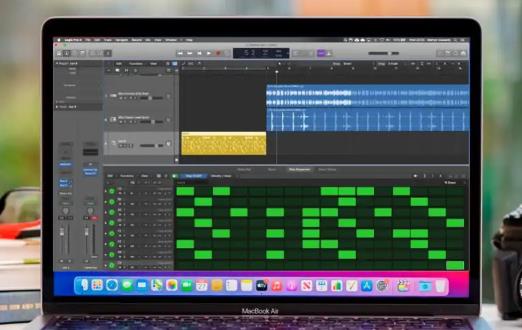What Computers Can Run Logic Pro X? All You Need To Know
Here is all about What Computers Can Run Logic Pro X? Logic Pro is a well-liked program among music producers of all sizes. It is a good pick because of its user-friendliness and other advantages. However, one of Logic’s most important characteristics is that it is only available on Apple machines.
Those who have decided unmistakably that Logic Pro is their favorite DAW will find themselves at a fork in the road when determining which machine to buy. Which Apple machine would be best for Logic Pro, given the wide choice of options?
What Computers Can Run Logic Pro X?
So, which Mac should you buy if you want to use Logic Pro X? The 24-inch iMac with the Apple M1 CPU is the best Mac for Logic Pro. The M1 chip outperforms prior generations in terms of performance for the same price. Furthermore, instead of the fusion drives used in certain prior models, this line of Macs is equipped completely with SSD storage.

While this model is one of the best for Logic Pro, there are a few reasons you might want to hold off on purchasing one. Some rumors about Apple’s plans may tempt you to wait. For example, the iMac has drawbacks for performing musicians, as well as the ability for certain individuals to save hundreds of dollars by switching to a different machine. This post will go over all of this and more.
What do You need To Run Logic Pro X?
There are eight factors to consider when deciding which Mac to purchase to run Logic Pro X:

GPU
Graphics processing isn’t a key concern for Logic Pro or music production. However, there are specific circumstances in which you should not disregard it. Some software, for example, may take advantage of the graphics processor for specific functions. Also, keep in mind that using several screens on a single computer can put an additional burden on the GPU.
Ports
Your setup will determine your port needs. Because many people use a completely in-the-box workflow, ports aren’t a big deal. However, if you intend to connect many external hard drives, a lot of analog circuitries, or other real-world equipment to the computer, you’ll need a system to handle it.
Portability
If you want to take your computer with you on the road, a mobile Mac is a good choice. The iMac versions, of course, are not suitable for this because they are desktop computers. If you desire portability, you should consider purchasing a notebook computer.
Price
Apple systems have a history of being more expensive than their competitors. Although an Apple Mac can still cost thousands of dollars, many more solutions are now available for people on a tighter budget.
Because the new M1 chip is Apple’s processor, you can get much more processing power for much less money than you could before. Macs range in price from $1000 to $7000, with Mac Pros starting at $5999.
Processor
Another factor that will significantly impact your music-producing experience is the CPU that your computer employs. You should get something powerful enough, if not more, for your needs. Apple laptops previously used Intel CPUs, which performed admirably at the time.
The new generation of proprietary Apple M1 CPUs, on the other hand, has completely transformed the power capabilities of Macs. These models are significantly more powerful than their Intel predecessors, and the amount of power you get for your money has increased dramatically.
The proprietary Apple M1 chip and native Apple software like Logic function together like a well-oiled machine. The only problem is that not all software supports Apple M1 yet. Therefore, some DAWs and plugins may not work on these newer computers.
On the other hand, the majority of developers will almost certainly change their software to support Apple M1 chips (Waves has already done this for many of its products free of charge). Getting an Apple Mac with an M1 chip is a no-brainer if you know you’ll only use it for native Apple software like Logic. However, remember that some third-party plugins may not work on your machine (at least for now).
Apple’s final M1 processor, the M1 Ultra, has been available since March 2022. This expands on the M1, M1 Pro, and M1 Max’s present capabilities. Regrettably, this is only available on the Mac Studio, which requires a significant financial investment.
Hard Drive
There were options for regular HDD storage, SSD storage, and fusion drive storage in previous Mac models (HDD combined with SSD). Apple Macs with the latest M1 processor models come with SSD storage as standard. Because music projects can quickly expand to large file sizes, it’s critical that your computer can handle them.
To give you a concept of what you should be looking for, 512GB is barely adequate for music creation, while 2TB would suffice for a smooth workflow. Because Macs require some space for operational resources, the claimed size may not accurately reflect the available space.
Operating System
Because Apple’s software is regularly updated, having a machine with a long shelf life is advantageous. If you buy an older model, you’ll soon run into a brick wall in terms of having an up-to-date operating system. The debut of the Apple M1 CPU in November 2020 will certainly hasten the process of obsolete previous model computers.
RAM
Because one of the initial bottlenecks in music creation is RAMMING, investing in a system that can handle your needs is critical. Apple Macs are renowned for being either un-customizable after purchase or making customization extremely difficult.
Most models only provide you flexibility at the point of sale, so ensure you obtain enough RAM to meet your requirements. Most users should have at least 16GB of storage, but newcomers on a budget should have at least 8GB. When most music projects are opened, they will only take up units of GB.
If you want to future-proof your Mac by doing more multitasking and utilizing other apps alongside Logic Pro, go for 16GB or more. You might get away with running extremely modest projects with 4GB because a small project can take up 1 to 2GB of RAM, but this is not something we would advocate.
What Macbook Pro Requirements Are Needed For Logic Pro X?
Excellent responses Increase the amount of RAM and the size of your hard drive. A few more pointers: Reduce the clutter on your hard drives, such as photos, Photoshop files, and email attachments. You should have a second PC to handle these.
Apps like Safari, Splice, Adobe Creative, and Parallels should be closed. Use CPU-intensive plugins sparingly. As much as feasible bounce MIDI to audio the easiest approach to get the most out of your MacBook Pro is to: Invest in an external hard disc. Transfer all of Logic’s instruments and samples to an external hard drive.

On that drive save all of your samples; you should also save your old Logic projects to an external drive. Move or redirect Dropbox to an external drive if you use it (and lower local storage to an absolute minimum). Make care to back it up after each session, of course.
Which Is More Necessary For Logic Pro X, Cores Or RAM?
You can run more plugins and have more tracks with a bigger number of cores. Because more cores equal greater processing power, CPU speed and the number of cores are more crucial when operating Logic Pro X smoothly.
If you’re using many sample-based instruments, such as symphonic libraries or drum instruments, having 32GB of RAM will help because they load their samples into RAM. RAM stores frequently used data so that your computer can retrieve it fast.
It also lets you run other apps at the same time, albeit Logic should be your primary open application for best benefits. Depending on how you use Logic, 16GB of RAM may be adequate. Both are critical, but the amount and speed of CPU cores impact Logic’s total responsiveness and power.
How to Choose the Best Mac for Logic Pro X?
Choosing the best Mac for Logic Pro X involves considering several factors to ensure optimal performance and a seamless music production experience. Here’s a guide to help you make the right decision:
- Performance: Look for a Mac with a powerful processor. As of my last update in September 2021, models with Apple’s M1 chip offer impressive performance and efficiency. However, newer models may be available by now, so research the latest chip options.
- RAM: Aim for a minimum of 8GB of RAM, but 16GB or more is recommended for smoother multitasking, handling large projects, and using virtual instruments.
- Storage: Opt for an SSD (Solid State Drive) for faster data access. Choose storage capacity based on your needs; 512GB or higher is recommended for storing projects, samples, and software.
- Screen Size and Resolution: Consider a screen size that suits your preferences and working style. A Retina display with a high resolution enhances visual clarity.
- Graphics: For music production, you don’t need a high-end GPU. Integrated graphics (like those in the M1 chip) are usually sufficient.
- Connectivity: Ensure the Mac has enough ports for your peripherals, such as USB, Thunderbolt, and headphone jacks.
- Compatibility: Verify that the Mac you’re considering is compatible with the latest version of Logic Pro X and any other software/plugins you plan to use.
- Future-Proofing: If possible, choose a Mac that will serve your needs for a few years without feeling outdated.
- Budget: Determine your budget and balance your needs for performance, RAM, and storage within that budget.
- Reviews and Benchmarks: Check reviews and benchmarks to understand real-world performance and user experiences.
- Apple Refurbished: Consider purchasing a certified refurbished Mac directly from Apple to save money while still getting a reliable and warrantied product.
- Upgrades: If the Mac you choose allows for upgrades, consider upgrading RAM and storage at the time of purchase for future flexibility.
- Consider Workflow: Reflect on your music production workflow, project complexity, and potential future needs. This will help you gauge the level of performance you’ll require.
- Warranty and Support: Factor in Apple’s warranty and customer support options when making your decision.
Remember that technology advances quickly, so stay updated with the latest Mac models, chip technologies, and user experiences by checking official Apple sources and technology news.
Best MACs for Logic Pro X
Here are some Mac models that were considered great options for running Logic Pro X effectively. However, keep in mind that newer models may have been released since then, so it’s recommended to research the latest offerings from Apple.
- MacBook Pro (13-inch, M1): The M1-equipped MacBook Pro offers excellent performance and efficiency. It’s a good choice for portability and handling moderate to demanding Logic Pro X projects.
- MacBook Pro (16-inch): The larger MacBook Pro models offer powerful processors, ample RAM options, and larger displays. These are suitable for more complex music production tasks.
- iMac (24-inch, M1): The M1-based iMac combines performance and a vibrant 4.5K Retina display. It’s a great option for those who prefer an all-in-one desktop setup.
- iMac Pro: Although Apple has discontinued the iMac Pro, you might find refurbished or pre-owned models. They were designed for professional-grade performance and handling resource-intensive tasks.
- Mac Pro: If you’re a professional music producer working on extremely demanding projects, the Mac Pro offers powerful customization options with high-end processors, ample RAM, and expansion possibilities.
When choosing a Mac for Logic Pro X, consider your specific needs, budget, and the complexity of your music production projects. As technology evolves, make sure to research the latest Mac models, chip advancements, and user experiences to find the best fit for your requirements.
Conclusion
Finally in a nutshell all about What Computers Can Run Logic Pro X? I believe the best Mac for Logic Pro X is an iMac if you want to use it in your home studio and a 14-inch MacBook Pro if you need a portable system.
However, remember that a new iMac could be delivered in the first half of 2022, as previously said. I’ve been using an Intel-based iMac for the past few years, which has served me admirably.
The obstacles, in this case, are readily evident. I have recently acquired a MacBook Air with an Apple M1 Chip, which has significantly improved performance. I believe my MacBook Air is more powerful in several aspects compared to my more expensive desktop iMac.
Logic Pro starts up instantly and I can load all the instruments in a flash. Even though my iMac is only a couple of years old, I’m confident I’ll sell it and upgrade to an M1 system within the next two years.
If you want to utilize Logic Pro X, which Mac should you get? The finest Mac for Logic Pro is the Apple M1-based 24-inch iMac. Compared to previous generations of chips at the same price point, the M1 processor provides significantly better performance. Additionally, this series of Macs is outfitted with entirely SSD storage instead of the fusion drives utilized in certain earlier models.
Frequently Asked Questions
Is Logic Pro X only available on the Mac?
For DAWs, it’s an Editors’ Choice winner. Pro Tools, on the other hand, is another Editors’ Choice winner since it’s a fantastic, albeit pricey, tool. If you’ve already invested in Pro Tools, you might as well keep it. It’s the clear victor if you’re dedicated to working on a PC, while Logic Pro is only available on Macs.
Is Logic pro compatible with my Mac?
Almost any Mac can run a version of Logic Pro, perhaps not the most recent version. Apple has produced several additional Apple Silicon-based gadgets since the release of macOS Monterey a few months ago.
Is it feasible to use Logic Pro on a PC?
As previously stated, Logic Pro X is an Apple product that is not compatible with Windows. You could only do that by downloading an Apple-like emulator or simulator.
Why do musicians use Macs?
Compared to the various PCs available, Macs have been recognized to be more stable and consistent. They’re also quite simple to operate. Companies can focus more on testing the software than dealing with numerous hardware concerns because there are fewer Mac models to test music software against.

Rayssa is a native American. A group of specialized individuals raised her with a passion for gaming. Here she discovered that computer games can expand your creative mind to infinite possibilities. In recent years, she has gone beyond gaming as a means of entertainment to enjoy it as a passio
